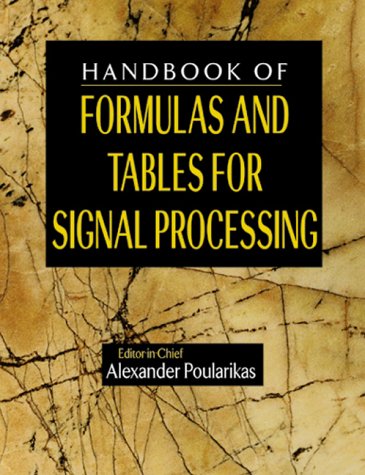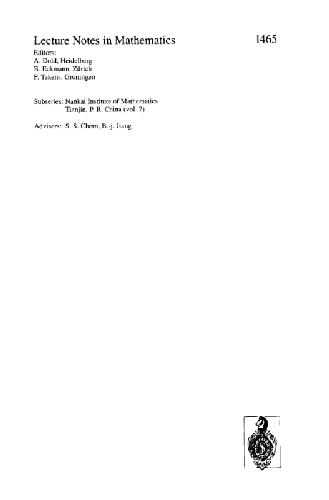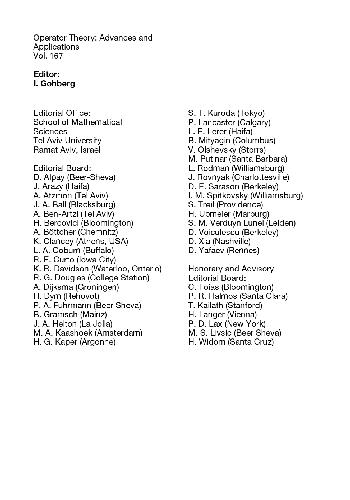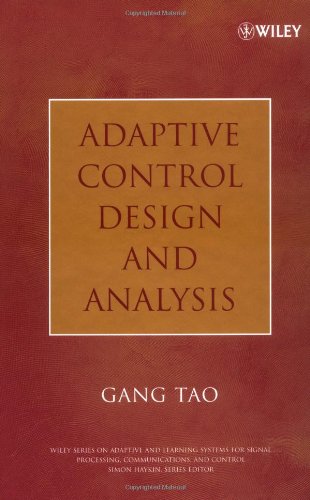Alexander D. Poularikas9780849385797, 0-8493-8579-2
Table of contents :
Handbook of Formulas & Tables for Signal Processing……Page 1
Electrical Engineering Handbook Series……Page 3
Copyright……Page 5
About the Author……Page 6
Preface……Page 7
Contents……Page 8
1.1 Definitions and Series Formulas……Page 11
1.2 Orthogonal Systems & Fourier Series……Page 16
1.3 Decreasing Coefficients of Trigonometric Series……Page 17
1.5 Two-Dimensional Fourier Series……Page 18
Examples……Page 19
References……Page 21
5.1.1 A Test Function……Page 22
2.1.4 Two-Sided Inverse Laplace Transform……Page 23
2.2.2 Methods of Finding the Laplace Transform……Page 24
2.3.2 Methods of Finding Inverse Laplace Transforms……Page 25
2.4.1 F(w) from F(s)……Page 26
TABLE 2.2 Table of Laplace Operations……Page 27
TABLE 2.3 Table of Laplace Transforms……Page 28
References……Page 44
1.2 Inversion in the Complex Plane……Page 45
Solution……Page 46
Solution……Page 47
Solution……Page 48
1.3 Complex Integration and the Bilateral Laplace Transform……Page 51
Solution……Page 52
3.1.1.1 Fourier Transform……Page 54
3.1.1.2……Page 55
3.1.2.1 Properties of Fourier Transform……Page 56
3.1.3.1 Graphical Representations of Some Fourier Transforms……Page 57
References……Page 81
Example 3.4……Page 82
4.1.2 Properties……Page 84
13.2.2.4 Shifting in omega-Domain……Page 86
References……Page 87
1.2 Two-Dimensional Discrete-Time Fourier Transform……Page 88
Example……Page 89
Example 5.2……Page 91
5.2.2 Properties……Page 92
5.3.2 Properties……Page 93
Example 5.6……Page 96
Example 5.9……Page 97
Example 5.11……Page 98
5.5.7 The Function d(a1x + b1y + c1, a2x + b2y + c2): From (5.5.5)……Page 99
Example 5.14……Page 100
References……Page 101
6.1.3 Region of Convergence for One-Sided Z-Transform……Page 102
6.1.4 Table of One-Sided Z-Transform Properties……Page 103
6.2.1 Definitions……Page 104
6.2.3 Properties of Two-Sided Z-Transform……Page 105
6.3 Inverse Z-Transform……Page 106
6.4 Positive-Time Z-Transform Tables……Page 110
References……Page 116
Example 6.3……Page 117
Example 6.4……Page 118
Example 6.6……Page 119
Example 6.9……Page 120
Example 6.10……Page 121
Example 6.11……Page 122
Example 6.13……Page 123
7.2.1 Equivalent Noise Bandwidth……Page 124
7.3.2 Rectangle (Dirichlet) Window……Page 127
7.3.3 Triangle (Fejer, Bartlet) Window……Page 128
7.3.4 cosa (t) Windows……Page 129
7.3.6 Hamming Window……Page 130
7.3.8 Blackman Window……Page 131
7.3.9 Harris-Nutall Window……Page 132
7.3.12 Riemann Window……Page 133
7.3.14 Cosine Taper (Tukey) Window……Page 134
7.3.15 Bohman Window……Page 135
7.3.17 Hann-Poisson Window……Page 136
7.3.18 Cauchy (Abel, Poisson) Window……Page 137
7.3.20 Dolph-Chebyshev Window……Page 138
7.3.21 Kaiser-Bessel Window……Page 139
7.3.23 Highest Sidelobe Level versus Worst-Case Processing Loss……Page 140
References……Page 141
8.1.3 Region of Convergence (ROC)……Page 142
8.1.7 Sequences with Support Everywhere……Page 143
8.2.1 Properties of the Z-Transform……Page 144
8.3.1 Inverse Z-Transform……Page 145
8.5.3 Theorem 8.5.1.3 (Huang, 1972)……Page 147
Example 8.1……Page 148
Example 8.3……Page 149
Example 8.4 (inverse integration)……Page 150
Binomial Coefficients……Page 151
Generalized Mean……Page 153
Triangle Inequalities……Page 154
9.3.3 Theorems on Prime Numbers……Page 155
9.3.11 Mersenne Primes……Page 156
9.3.17 Hexadecimal System……Page 157
9.3.18 Special Numbers in Different Number Bases……Page 158
9.5.1 Algebraic Equation……Page 159
9.5.7 Quadratic Equations……Page 160
9.5.9 Binomic Equations……Page 161
9.7.1 Definitions……Page 162
9.8.2 l’Hospital’s Rules……Page 163
9.9.2 Integration Properties……Page 164
9.9.4 Integrals of Rational Algebraic Functions (constants of integration are omitted)……Page 165
9.9.5 Integrals of Irrational Algebraic Functions……Page 166
9.9.6 Exponential, Logarithmic, and Trigonometric Functions……Page 168
9.9.9 Improper Integrals……Page 169
9.9.13 Properties of Stieltjes Integrals……Page 170
Example……Page 171
9.12 Convergence of Infinite Series……Page 172
9.13.2 Power Series……Page 173
9.13.5 Order Concepts……Page 174
9.14 Sums & Series……Page 175
32.2.4 Hypothesis Testing for the Variance of a Normal Distribution:……Page 177
32.2.5 One-Sided Alternative Hypothesis for Means……Page 178
32.2.6 One-Sided Tests for the Population Variance of a Normal Distribution……Page 179
References……Page 180
10.1.2 Pulse Function……Page 181
10.1.6 Sinc Function……Page 182
10.1.10 Exponentially Decaying Cosine Function……Page 183
10.1.13 Cotangent Function……Page 184
10.1.16 Arcsine Function……Page 185
10.1.19 Parabola Function……Page 186
10.1.22 Cubical Parabola……Page 187
10.2.3 Real Exponential Sequence……Page 188
10.2.6 Exponentially Decaying Cosine Function……Page 189
10.3.2 The Pulse Function……Page 190
10.3.5 The Gaussian Function……Page 191
10.3.6 The Sinc Function……Page 192
11.1.2 Discrete Fourier Transform of Sampled Functions……Page 193
11.3.2 DFT of Cyclic Convolution (see Section 11.3.1)……Page 194
Program 11.1: Radix-2 DIF FFT……Page 195
Program 11.2: Radix-2 DIT FFT……Page 196
Program 11.3: Split-Radix FFT without Table Look-up……Page 198
Program 11.4: Split-Radix with Table Look-up……Page 202
Program 11.5: Inverse Split-Radix FFT……Page 207
Program 11.6: Prime Factor FFT……Page 212
Program 11.7: Real-Valued Split-Radix FFT……Page 216
Program 11.8: Inverse Real-Valued Split-Radix FFT……Page 220
References……Page 224
12.1.2 Filter Transfer Function……Page 225
12.2.1 Definition of Butterworth Low-Pass Filter……Page 226
12.4.4 Butterworth Normalized Low-Pass Filter……Page 227
12.4.5 Butterworth Filter Specifications (see also Figure 12.1)……Page 228
Solution:……Page 229
12.5.2 Recursive Formula for Chebyshev Polynomials……Page 230
12.5.3 Table 12.2 gives the first ten Chebyshev polynomials……Page 231
12.5.6 Pole Location of Chebyshev Filters……Page 232
Left-Hand Poles for the Transfer Function……Page 233
Solution……Page 234
12.6.3 Attenuation……Page 237
12.7.2 Properties of the Rational Function Rn(w)……Page 238
12.7.4 Steps to Calculate the Elliptic Filter……Page 239
Steps……Page 241
Example 12.3 Requirements for an Elliptic Filter:……Page 243
References……Page 244
13.1.2.1 Transform of Derivatives……Page 245
13.1.2.7 Convolution……Page 246
13.2.1 Definition FST……Page 247
13.2.2.7 Integration in the t-Domain……Page 248
Exponential Function……Page 249
13.3.2 Discrete Cosine Transform (DCT)……Page 250
13.5.3 Scaling……Page 251
13.6.2 FST of Real Data Sequence……Page 252
13.7.2 Fourier Cosine Transform Pairs……Page 253
13.8.2 Fourier Sine Transform Pairs……Page 256
13.9 Notations & Definitions……Page 258
References……Page 260
14.1.2 Definition of the Pair with Use of f (units: s –1 )……Page 261
14.1.5 Signs of the cas Function……Page 262
14.2.1 Relationship to Fourier Transform……Page 263
14.3.2 Phase Spectrum……Page 264
14.4.6 Modulation……Page 265
14.4.9 Product……Page 266
14.4.14 Hartley Transform Properties……Page 267
14.5.2 Example (Shifted Gaussian)……Page 268
14.5.7 Example (Cosine)……Page 269
14.5.12 Example……Page 270
14.7 Tables of Fourier & Hartley Transforms……Page 271
14.8.2 Relation to Fourier Transform……Page 273
14.9.3 A C Program for Fast Hartley Transforms……Page 274
References……Page 279
Convolution form representation……Page 280
15.1.2 Analytic Signal……Page 281
15.2.2 Fourier Spectrum of the Analytic Signal……Page 282
15.4.1 Hilbert Transform of Period Functions……Page 283
15.5.1 Hilbert Transform Properties……Page 284
15.5.3 Parseval’s Theorem……Page 285
15.5.6 Hilbert Transform Pairs……Page 286
15.6.3 Fourier Transform of Hilbert Transform……Page 290
15.7.2 Table of Hilbert Transform of Hermite Polynomials……Page 291
15.7.4 Hilbert Transform of Orthonormal Hermite Functions……Page 292
15.9.1 Hilbert Transform of Bessel Function:……Page 293
15.10.1 Instantaneous Angular Frequency……Page 294
15.12.1 Causal Systems……Page 295
15.13.3 DHT of a Sequence x(i) in the Form of Convolution……Page 296
15.14.2 Discrete Hilbert Transform……Page 297
15.14.4 Shifting Property……Page 298
15.15.3 All-Pass Filters……Page 299
Equivalent Notation……Page 301
15.16.2 Ideal Hilbert Transformer With Linear Phase Term……Page 302
Amplitude of Hilbert Transformer……Page 303
15.17.1 IIR Ideal Hilbert Transformer……Page 304
Example……Page 305
References……Page 306
16.1.2 Other Interpretation……Page 307
16.1.4 Rotated Coordinate System……Page 309
Example……Page 310
16.3.3 Similarity……Page 311
16.3.8 Linear Transformation……Page 312
16.3.9 Examples:……Page 313
Example……Page 318
Example……Page 319
16.7.1 N-Dimensional Radon Transform with its Properties……Page 320
16.8.4 Abel Transform Pairs……Page 321
16.9.1 Back Projection……Page 322
16.9.5 Filter of Backprojection……Page 323
16.10.1 Abel and Radon Pairs……Page 324
References……Page 327
Example……Page 328
Example……Page 329
17.2.6 Moment……Page 330
17.3.6 Example……Page 331
17.4.3 Example……Page 332
17.5 Hankel Transforms of Order Zero……Page 333
References……Page 336
18.1.3 Relation to Fourier Transform……Page 337
18.2.6 Multiplication by a Power of ln t……Page 338
18.2.10 Multiplicative Convolution……Page 339
18.3.4 Example……Page 340
18.4.5 Functional Relations……Page 341
18.4.8 Riemann’s Zeta Function……Page 342
18.5.1 Tables of Mellin Transform……Page 343
References……Page 345
19.1.2 Definition of WD in Frequency Domain……Page 346
19.2.1 Conjugation……Page 347
19.2.7 Ordinates……Page 348
19.2.12 Fourier Transform……Page 349
19.2.16 Total Energy……Page 350
19.2.20 Convolution Covariance……Page 351
19.2.21 Modulation Covariance……Page 352
19.2.25 Group Delay……Page 353
19.2.30 Chirp Convolution……Page 354
19.2.32 Moyal’s Formula……Page 355
19.2.36 Analytic Signals……Page 356
19.4.1 WD Properties and Ideal Time-Frequency Representations……Page 357
19.5.1 Table Signals with Closed-Form Wigner Distributions (WD) and Ambiguity Functions (AF) (See………Page 361
19.7.1 Cohen’s Class……Page 364
19.7.3 Table of Time-Frequency Representations of Cohen’s Class……Page 367
19.10.1 WD of Discrete-Time Signals x(n) and g(n)……Page 369
19.11.5 Inner Product……Page 372
19.11.9 Inverse Transform in Time……Page 373
19.11.12 Inner Product of Signals……Page 374
19.11.16 Multiplication in Time Domain……Page 375
19.12.1 Table of WD of Discrete-Time Functions……Page 376
References……Page 379
20.1 Basic Concepts……Page 380
20.3.1 Continuous Function……Page 381
20.3.7 Rules of Differentiation……Page 382
20.5.1 Complex Exponential Function……Page 383
20.5.8 Other Hyperbolic Relations……Page 384
Example……Page 385
20.7.3 Cauchy First Integral Theorem……Page 386
20.7.8 Derivative of an Analytic Function W(z)……Page 387
20.7.11 Taylor’s Theorem……Page 388
20.8.1 Laurent Theorem……Page 389
Example……Page 391
20.9.3 Nonessential Singularity (pole of order m)……Page 392
Example……Page 393
20.10.3 Theorem……Page 394
20.10.5 Residue with Nonfactorable Denominator……Page 395
20.11.3 Maximum Value Over a Path, Theorem……Page 396
20.11.5 Theorem (Mellin 1)……Page 397
Example……Page 398
20.12.1 Definition of the Bromwich Contour……Page 399
20.12.2 Finite Number of Poles……Page 400
Solution……Page 401
20.13.1 Definition of Branch Points and Branch Cuts……Page 402
Example……Page 403
20.14.1 Evaluation of the Integrals of Certain Periodic Functions……Page 409
20.14.2 Evaluation of Integrals with Limits……Page 410
20.14.3 Certain Infinite Integrals Involving Sines and Cosines……Page 411
Example……Page 412
Steps……Page 414
20.15.1 Cauchy Principal Value……Page 420
20.16 Integral of Logarithmic Derivative……Page 421
References……Page 424
21.1.4 Recursive Formulas……Page 425
21.1.1 Definition……Page 209
21.1.5 Legendre Differential Equation……Page 426
21.1.9 Series Expansion……Page 427
Example……Page 428
Example……Page 430
21.3.3 Properties……Page 431
21.4.2 Second Stieltjes Theorem……Page 432
21.5 Table of Legendre & Associate Legendre Functions……Page 433
References……Page 436
22.1.3 Generating Function……Page 437
22.3 Integral Representation……Page 438
Example……Page 439
22.5 Properties of Hermite Polynomials……Page 440
References……Page 441
23.1.1 Definition……Page 442
23.3.3 Laguerre Series……Page 443
23.6.2 Orthonormal Functions……Page 444
Example……Page 445
23.7 Tables of Laguerre Polynomials……Page 446
References……Page 448
24.3.1 Relations……Page 449
24.7 Table of Chebyshev Properties……Page 450
References……Page 451
25.1.2 Definition of Nonintegral Order……Page 452
25.2.1 Recurrence Relations……Page 453
25.3.1 Integral Representation……Page 454
Example……Page 455
25.4.2 Product Property……Page 457
Example……Page 458
25.5 Properties of Bessel Function……Page 459
25.6.2 Recurrence Relations……Page 465
25.7.4 Expansion Form……Page 466
References……Page 467
26.1.2 Orthogonality Property……Page 468
26.2.1 Zernike Series……Page 470
26.2.2 Expansion of Real Functions……Page 473
References……Page 474
27.1.3 Beta Function……Page 475
27.1.4 Properties of G(x)……Page 476
27.1.7 Definition of Beta Function……Page 477
27.1.9 Table of Gamma and Beta Function Relations……Page 478
27.3.1 Sine Integral……Page 480
27.4.3 Values at Infinity……Page 481
27.5.6 Special Values……Page 482
27.6.6 Differential Equations……Page 483
27.6.7 Table of Complete Elliptic Integrals……Page 484
References……Page 485
28.1.4 Examples……Page 486
28.2.1 Bernoulli’s Numbers Bn (n = 1,2, …)……Page 487
28.2.3 Euler’s Constant……Page 488
28.4.1 Sum of Powers……Page 489
Example……Page 490
References……Page 491
29.1.2 Phase and Group Delays……Page 492
29.2.2 Fourier Series……Page 493
Solution……Page 494
29.4.1 Rectangular……Page 495
Solution……Page 496
29.4.6 Window Parameters……Page 497
Steps for Design……Page 498
29.5.1 Transition Width……Page 499
29.7 Bandstop FIR Filter……Page 500
Solution……Page 501
30.2.2 Conditions……Page 502
Solution……Page 503
30.3.4 Stability……Page 504
30.5.4 Bilinear Transformation……Page 505
30.5.8 The Warping Effect……Page 506
Example……Page 507
References……Page 508
31.1.4 Loss Amplitude……Page 509
31.2.1 Butterworth Filters……Page 510
31.2.3 Elliptic Filters……Page 511
31.3.1 Lowpass and Highpass Filters (see Figure 31.2)……Page 512
31.3.2 Bandpass and Bandstop Filters (see Figure 31.3)……Page 513
31.4.1 Example……Page 514
31.4.3 Example……Page 515
References……Page 516
Example 2……Page 517
32.1.1.10 Efficient Estimator……Page 518
Example 2……Page 519
32.1.2.6 CRLB-Vector Parameter……Page 520
32.1.2.8 Vector Transformations CRLB……Page 521
Example 1……Page 522
Example……Page 523
32.1.6.1 Definition……Page 524
32.1.6.6 Order-Recursive LS……Page 525
32.1.6.8 Sequential Least Squares Error……Page 526
32.1.7.2 Vector Parameter……Page 527
Example 1……Page 528
32.1.8.4 Linear Model (posterior p.d.f. for the general linear model)……Page 529
Example 1……Page 530
Example 1……Page 531
32.2.3.1……Page 532
Steps……Page 176
32.2.4.1 Steps……Page 533
Example 1……Page 534
Example 1……Page 204
Ch33 Matrices……Page 537
Example……Page 538
33.1.8 Matrix-Vector Multiplication……Page 0
Example……Page 539
Example……Page 540
33.1.18 Hankel……Page 541
Example……Page 542
Example……Page 543
Example……Page 544
33.5.6 Orthogonal……Page 545
33.7.2 Partitioned……Page 546
33.8.4 Properties……Page 547
Example……Page 548
Example……Page 550
Example……Page 551
33.11.4 Distance from Projection……Page 552
33.13.2 Characteristic Polynomial……Page 553
33.13.5 Properties of Norms……Page 554
33.14.3 Properties of g-inverse……Page 555
33.15.1 Computation (theorem)……Page 556
Example……Page 557
Example……Page 558
33.16.5 Steps to find……Page 559
33.18.3 Minimization of Sum of Squares of Deviations……Page 560
33.19.5 Solution with L-Inverse……Page 561
33.20.1 The Inverse of a Partitioned Matrix……Page 562
Example……Page 563
33.24.2 Upper Triangular……Page 564
33.24.13 Orthogonal Decomposition……Page 565
33.26.2 Properties of Direct Products……Page 566
33.27.2 Properties……Page 567
33.28.4 Properties……Page 568
Example……Page 569
33.30.1 Definition……Page 570
Example……Page 571
33.33.1 Definitions……Page 572
33.34.1 Derivative of a Function with Respect to a Vector……Page 573
33.34.10……Page 574
References……Page 575
34.1.1 Axioms of Probability……Page 576
34.2.5 Properties……Page 577
Example……Page 578
34.3.9 Poisson Theorem……Page 579
Example……Page 580
34.4.5 Tables of Distribution Functions……Page 581
34.4.6 Conditional Distribution……Page 591
Example……Page 601
Example 4……Page 602
34.5.9 Variance……Page 603
34.5.13 Generalized Moments……Page 604
34.5.16 Second Characteristic Function……Page 605
34.6.3 Conditional Distribution Function……Page 606
34.6.9 Jointly Normal r.v…….Page 607
Example 2……Page 608
34.8.2 Density Function……Page 609
34.8.4 Functions of Independent r.v.’s……Page 610
34.9.5 Correlation Coefficient……Page 611
Example……Page 612
34.11.1 Jointly Normal……Page 613
34.12.2 Characteristic Function with Means……Page 614
Example……Page 615
34.14.2.5 Variance of Uncorrelated r.v.’s……Page 616
34.14.3.1 Density Function……Page 617
34.14.4.3 Stochastic Convergence……Page 618
Example……Page 619
34.15.1.4 Distribution Function (2nd order)……Page 620
34.15.1.11 Distribution Function……Page 621
Example……Page 622
34.17.1.2 Mean of Output……Page 623
34.17.3.5 Continuity of Stationary Process……Page 624
34.17.4.5 Variance of S……Page 625
34.17.4.8 Ergoticity of the Autocorrelation……Page 626
34.18.2.1 Power Spectrum (spectral density)……Page 627
34.18.2.4 Relationships Between Processes……Page 629
34.18.3.2 Mean……Page 630
34.18.3.9 Multiple Terminals Spectra……Page 631
Example……Page 632
34.18.3.14 Periodic Processes in Linear System……Page 633
34.18.4.3 Bandpass Process……Page 634
Examples……Page 635
Example……Page 636
Step 3……Page 637
34.21.1.1……Page 638
34.21.2.3 Linear Systems……Page 639
34.22.3.1 Markoff Process……Page 640
References……Page 641
35.1.2.1 Average (mean value)……Page 642
35.1.3.2 Wide-sense Stationary (or weak)……Page 643
35.1.4.2 White Noise (sequence)……Page 644
35.1.5.7 Expectation of Vectors……Page 645
35.1.5.10 Complex Gaussian Vector……Page 646
35.1.7.4 Complex Vector Parameter u……Page 647
35.1.9.2 Output Power……Page 648
35.1.10.3 Yule-Walker Equations for ARMA Process……Page 649
35.1.10.8 Moving Average Process (MA)……Page 650
35.2.1.3 Denominator Coefficients (ap(p))……Page 651
35.2.2.1 Prony’s Signal Modeling……Page 652
35.2.3.1 Shank’s Signal Modeling……Page 653
35.2.5.1 Normal Equations……Page 654
35.3.1.1 All-Pole Modeling……Page 655
35.3.1.4 Properties……Page 656
Example……Page 657
Example……Page 658
35.4.3.1 Forward Covariance Method……Page 661
35.4.1.4 (j+1) Order Coefficient……Page 659
35.4.1.11 p th -Order FIR Lattice Filter……Page 660
Example……Page 662
35.4.3.3 Burg’s Method……Page 663
Example 1……Page 664
35.4.4.3 Burg Reflection Coefficient……Page 665
References……Page 666
36.1.1.3 Power Spectrum Using the Data……Page 667
36.1.2.2 Properties……Page 668
36.1.5.2 Properties……Page 669
36.2.1.3 Steps……Page 670
36.2.2.2 Methods to Find Parameters……Page 671
References……Page 672
37.1.2.1 Estimate……Page 673
Solution……Page 674
37.1.2.8 Linear Prediction……Page 675
Example (smoothing)……Page 676
37.1.3.2 Causal IIR Wiener Filter……Page 677
Solution……Page 678
37.2.1.3 Matrix Form of Stationary AR(p) Process……Page 679
Example……Page 680
37.3.1.7 Data……Page 681
37.3.2.4 Steepest Descent Adaptive Filter……Page 682
Example (adaptive linear prediction):……Page 684
37.3.3.2 IIR LMS Algorithm……Page 686
37.3.5.1 Input Signals……Page 687
37.3.6.1 Filter Configuration……Page 688
References……Page 690
38.1.4 Properties of Bandlimited Functions……Page 691
38.2.1 Interpolation Function……Page 692
38.2.7 Truncation Error……Page 693
38.3.2 Train of Pulses with Flat Tops……Page 695
38.7.1 One System……Page 696
38.8.1 Bounds of Output Function……Page 697
References……Page 698
39.1.1.3 Cumulates (semi-invariants)……Page 699
39.1.2.2 Partitions of Set {1,2,3,4}……Page 700
39.1.3.1 Properties……Page 701
Example……Page 702
39.2.1.3 Bispectrum n = 3……Page 703
39.2.1.5 Triaspectrum n = 4……Page 704
39.2.1.15 Linear Phase Shifts……Page 705
39.4.1.2 Output of LTI System……Page 706
39.4.3.3 Non-Minimum or Mixed Phase MA System……Page 707
39.5.1.1 Higher-Order Statistics Estimates……Page 708
39.5.3.3 Direct Method……Page 709
References……Page 710
40.2.1.1 Inverse Transform Method……Page 711
40.3.1.1 Exponential Distribution……Page 712
40.3.3.1 Beta Distribution……Page 713
40.3.4.1 Normal Distribution……Page 714
40.3.8.1 Chi-Square Distribution……Page 715
40.3.10.1 F Distribution……Page 716
References……Page 717
Example……Page 718
41.3.2 Median Filter Algorithms……Page 719
Example……Page 720
41.4.6.1 Modified Trimmed Mean Algorithm……Page 721
41.4.8.1 K-Nearest Neighbor Filter Algorithm……Page 722
41.5.3 L-Filters Algorithms……Page 723
41.6.5 Weighted Median Algorithm……Page 724
41.8.1 Purpose……Page 725
41.9.4 y Function in Use……Page 726
41.9.5 M-Filter Algorithm……Page 727
41.10.5 Winsorized Wilcoxon Filters……Page 728
References……Page 729
42.1.3 Admissible Conditions……Page 730
42.1.6 Regularity……Page 731
42.1.11 Constant Fidelity Analysis……Page 732
42.2.6 Two-Scale Relation……Page 733
42.2.8 Two-Scale Relations in the Frequency Domain……Page 734
42.2.10 Orthogonal Wavelet Decomposition……Page 735
42.2.11 Recursive Reconstruction……Page 736
42.3.3 Perfect Reconstruction……Page 737
42.3.4 Orthogonal Filter Bank……Page 738
42.3.6 Example……Page 739
42.3.7 Biorthogonal Filter Bank……Page 740
42.3.9 Biorthogonal Wavelet Decomposition……Page 741
42.4.1 Gabor-Wavelets……Page 742
42.4.3 Haar Basis……Page 743
42.4.4 Daubechies Basis……Page 744
42.4.5 Splines……Page 745
42.4.6 Lemarie-Battle Basis……Page 746
References……Page 747
43.1.1.3 Trigonometric functions of an arbitary angle (see Figure 43.1)……Page 748
43.1.3.1 Fundamental Identities……Page 749
43.1.3.3 Angle-Sum and Angle-Difference Relations……Page 750
43.1.3.6 Function-Product Relations……Page 751
43.1.3.9 Power Relations……Page 752
43.1.3.12 Identities Involving Principal Values……Page 753
43.1.3.13 Plane Triangle Formulae……Page 754
43.1.3.15 Solution of Oblique Triangles……Page 756
43.2.1.1 Geometrical Defintions (see Figure 43.2)……Page 757
43.2.1.3 Fundamental Identities……Page 758
43.2.1.4 Inverse Hyperbolic Functions*……Page 760
43.2.1.5 Relations with Circular Functions……Page 761
43.2.1.6 Special Values of Hyperbolic Functions……Page 762
44.1 Factors & Expansions……Page 763
44.4 Sums of Powers of Integers……Page 764
44.5.1.6 Arithmetic Power Series……Page 765
44.5.2.2 Exponential Functions……Page 766
44.5.2.4 Trigonometric Functions……Page 767
44.5.2.5 Inverse Trigonometric Functions……Page 768
44.5.2.6 Hyperbolic Functions……Page 769
44.6 Partial Fractions……Page 770
44.6.4 Repeated Quadratic Factor……Page 771
44.7.3 Trigonometric Solution of Cubic Polynomials……Page 772
Example……Page 773
44.7.6 Polynomial Norms……Page 774
45.1 Derivatives……Page 775
Example……Page 778
45.3.1 Elementary Forms……Page 783
45.3.2 Forms Containing Containing (a+bx)……Page 785
45.3.5 Forms Containing ………Page 787
45.3.6 Forms Containing a+bxn……Page 788
45.3.7 Forms Containing a+bx+cx2……Page 790
45.3.8 Forms Containing sqrt(a+bx)……Page 791
45.3.9 Forms Containing sqrt(x2-a2))……Page 792
45.3.10 Forms Containing sqrt(a2-x2)……Page 794
45.3.11 Forms Containing sqrt(a+bx+cx2)……Page 796
45.3.12 Forms Containing sqrt(2ax-x2)……Page 797
45.3.13 Miscellaneous Algebraic Forms……Page 798
45.3.14 Forms Involving Trigonometric Functions……Page 799
45.3.15 Forms Involving Inverse Trigonometric Functions……Page 805
45.3.16 Forms Involving Trigonometric Substitutions……Page 806
45.3.17 Logarithmic Forms……Page 807
45.3.18 Exponential Forms……Page 808
45.3.19 Hyperbolic Forms……Page 811
45.3.20 Definite Integrals……Page 813







Reviews
There are no reviews yet.